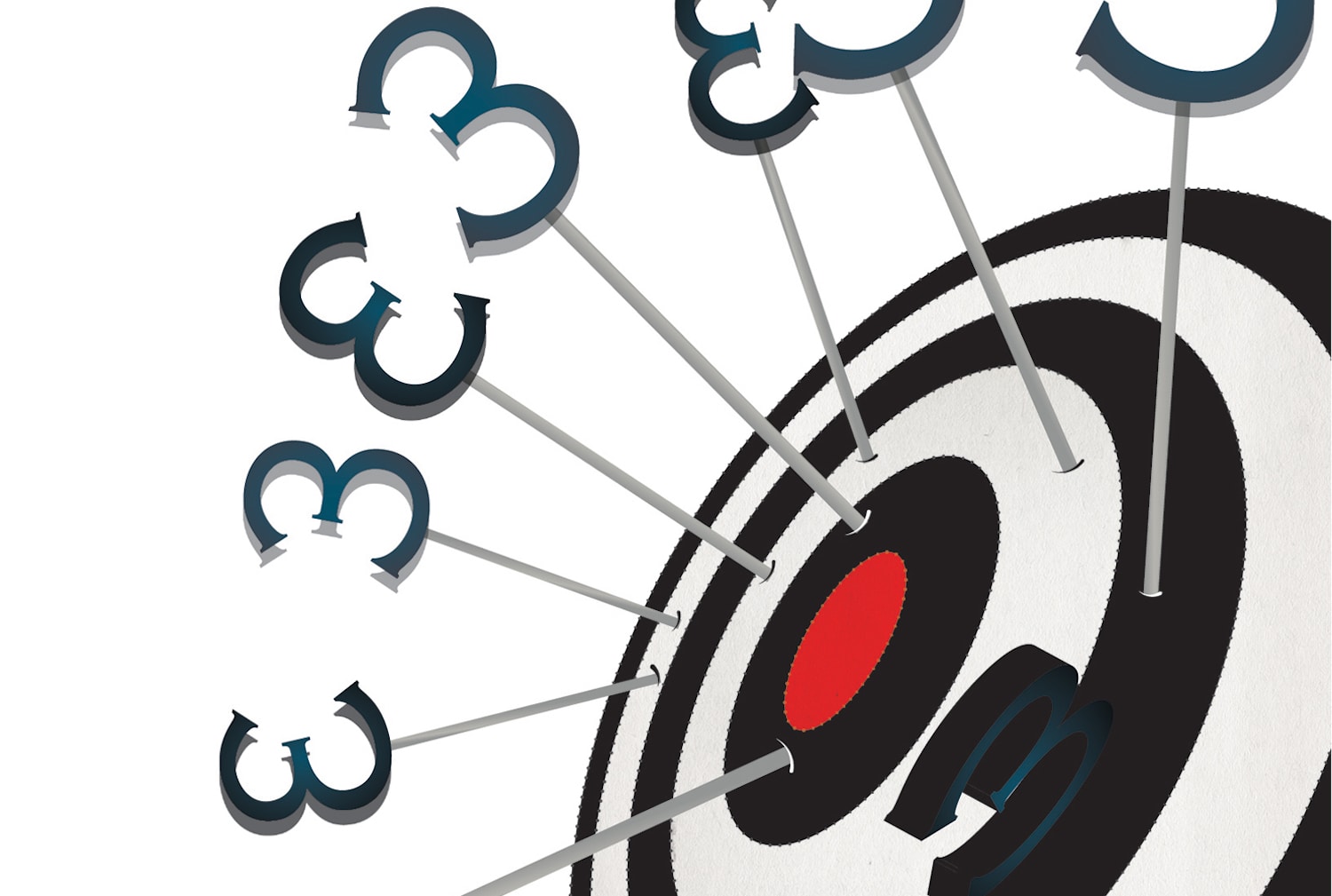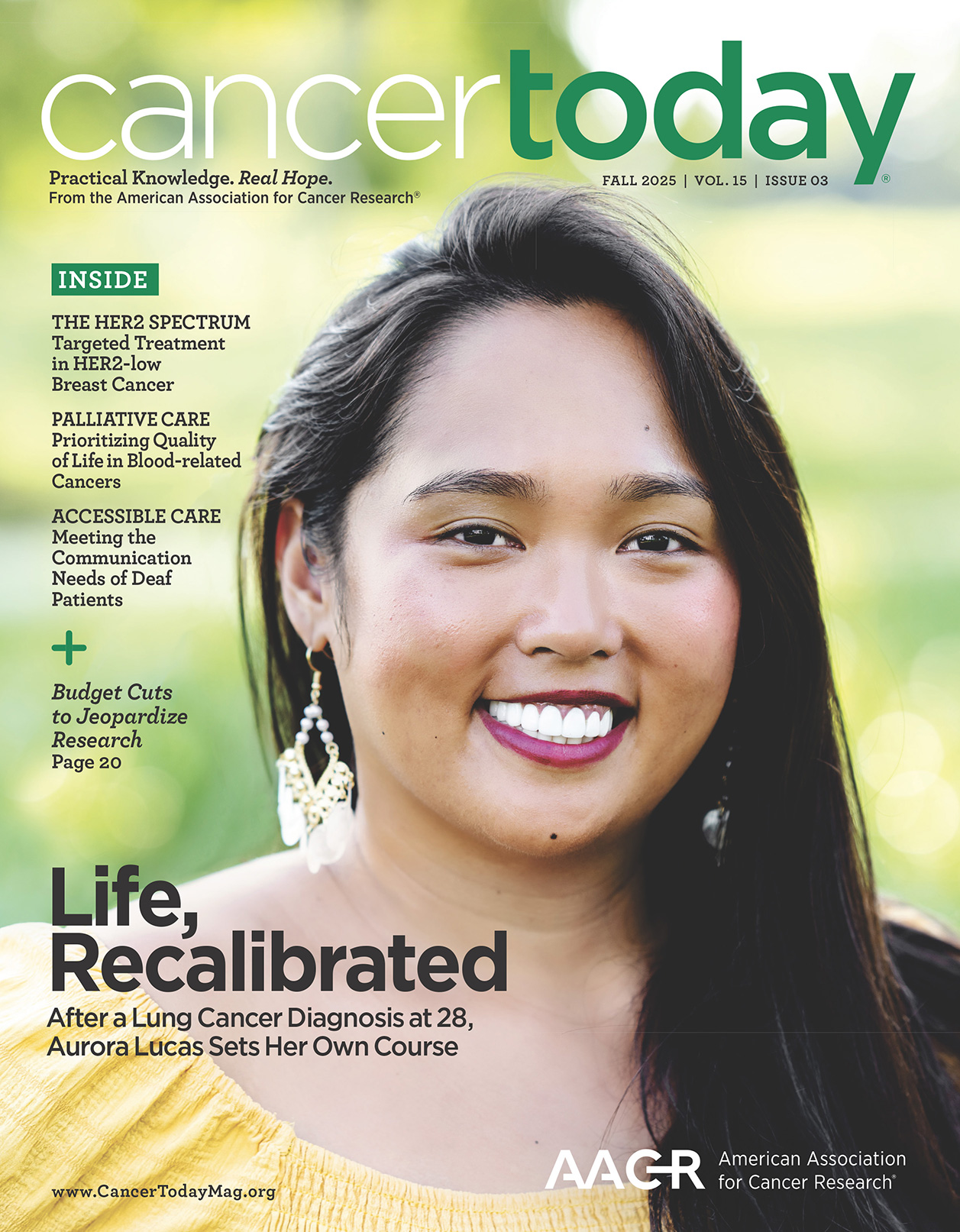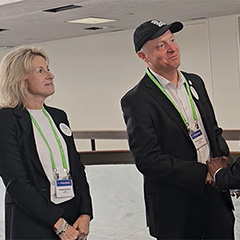IF YOU ARE A PERSON WHO LIKES TO GAMBLE, the Super Bowl may be the event for you. Some Vegas oddsmakers have correctly predicted 16 of the last 21 winners—a 75 percent success rate.
Even so, odds are just that: odds. Time after time the team that just can’t lose does. In the wake of such upsets, sports announcers typically turn to clichés like “misplaced expectations” and “false hopes.”
Similar platitudes are often heard when a large phase III clinical trial falls short—when a therapy or drug combination that companies have often spent hundreds of millions of dollars and more than a decade developing doesn’t do better than the current standard of care, or does even worse. The difference, however, is that cancer is not a game.
It’s easy to assume that a new therapy being studied in a phase III trial will come out ahead. After all, it’s already made it through preclinical studies, phase I testing for best dosage and safety, and larger phase II trials examining safety and effectiveness. But in fact, the probability of a positive phase II study predicting that a phase III drug will be better than the current standard of care is low—especially for new cancer drugs. Between 2003 and 2010, only 34 percent of new cancer drugs or drug combinations tested in phase III trials came out on top.
Scientists, it seems, aren’t doing as well as the oddsmakers, who are predicting a sport in which the game-winning touchdown may depend on the weather, an injured player, or random chance. It’s not possible to be certain that every treatment researchers send to a phase III trial will show a benefit. But there are strategies cancer researchers can pursue to make it more likely that a phase III trial achieves its goal.
Rush to Results
Why can’t phase III cancer trials do any better than a 1 in 3 success rate? Philip A. Philip, a medical oncologist at Karmanos Cancer Institute at Wayne State University in Detroit, points the finger at two problems: the inherent molecular and genetic complexity of cancer, and a “deficiency and fault in the way we do trials.” That second problem, he believes, is a result of the pressure that clinical trials investigators face from pharmaceutical companies as well as patients and their advocates to get new drugs on the market as quickly as possible. “In my opinion,” says Philip, “we are seeing a rush in taking drugs to phase III trials.”
Daniel J. Sargent, a biostatistician at the Mayo Clinic Cancer Center in Rochester, Minn., agrees. “For any one agent, we need to spend more time at phase II,” he says. “What I hear from pharmaceutical researchers is that they want to fail early. … No one is better off after investing tens of millions and hundreds of hours into a phase III trial that turns out to be negative.
- Preclinical studies: Laboratory research that takes place before a drug is tested in humans.
- Phase I clinical trials: Studies that test a new drug or treatment in a small group of people to evaluate its safety, side effects and best dosage.
- Phase II clinical trials: Studies that test the new drug or treatment in a larger group of people to evaluate safety and effectiveness.
- Phase III clinical trials: Studies that test the new drug or treatment in large groups of people to study its side effects and to confirm whether it is as or more effective than the current standard of care.
“Every time a large phase III trial fails,” Sargent continues, “we have enrolled patients who could have been treated with other investigational agents” in four, five or six smaller randomized phase II trials that might have identified a therapy more likely to be a phase III success.
Yet, as he notes, unless there is a known biomarker—a molecular or genetic indicator—that predicts the drug’s effectiveness, phase II results won’t be a guarantee. Phase II trials are small, “which means, by their nature, they will have more false positives”—drugs that look like they are effective but aren’t.
Some factors that influence a drug’s success don’t become evident until the drug is tested in a large, diverse population, explains Sargent. Variation in tumor types not seen in a small phase II trial might not come into play until the therapy is studied in a bigger group of people. Similarly, racial or ethnic differences that affect a drug’s effectiveness might not be apparent until a drug is studied internationally. Whether the patients in the phase III trial have tried more previous therapies than those in the phase II study can influence how well the drug seems to work, too.
Hitting the Mark
There are ways to conduct phase II trials that could improve the odds in phase III. One option, says Eric Chen, a medical oncologist at the Princess Margaret Cancer Center in Toronto, is to test the drug more extensively—on more patients—in phase II trials before the decision is made to initiate a phase III trial. Another is to find and use better biomarkers that can help enroll a more targeted patient population.
Researchers might also avoid disappointment by testing a drug for a new patient population in a phase II trial, rather than a phase III one. This is especially important, Sargent notes, when they are testing a drug on early stage tumors after it has been shown to be effective against metastatic cancer. “That is a big risk,” he says. “It is changing the patient population. In colorectal cancer, where I’ve done my work, the jump from the metastatic to the [early stage] setting is a very hazardous one. We have had several agents with spectacular failures, like Erbitux (cetuximab), which was active in the metastatic setting” but was not effective in phase III trials that examined its ability to prevent recurrence after surgery.
Implementing a randomized design (with different groups of patients receiving different treatments) in more phase II trials could also reduce phase III failures. If the new therapy isn’t compared with anything, it’s difficult to interpret overall survival or progression-free survival, because researchers don’t know if the study participants might have done well regardless, says Ross Camidge, a thoracic oncologist at the University of Colorado Hospital, in Aurora. It’s also not possible to determine if a biomarker is accurate unless there are people with and without the marker who are in the trial. If you give the drug only to people who have the biomarker, Sargent explains, there is no way to know if the biomarker is predicting who will do well on the new therapy, or if it’s merely identifying people with a tumor type that would have a better prognosis regardless.
A successful phase III trial might not have a huge impact on cancer care.
A review by Eric Chen, a medical oncologist at the Princess Margaret Cancer Center in Toronto, published April 18 in the Journal of the National Cancer Institute, addresses another critical issue: the statistical dilemma researchers face when deciding how much of a benefit they hope to see in a phase III trial they are designing.
“If you assume that the new therapy will be a lot better than the current standard of care, then you’ll probably do a trial with a smaller number of patients,” explains Chen. If it doesn’t perform as well as you expected, then you’ll have a negative trial—even though you might have had a positive outcome if you had expected less benefit.
On the other hand, if you start out anticipating less benefit, then you’ll need to do a trial with a large number of patients to observe the small statistical benefit you expect. And if that trial is positive, he says, you then face another question: Whether that small statistical benefit is also a clinically meaningful benefit, as it might extend survival by only a month or two. In that case, you would have a positive trial that could be called a “success,” yet not dramatically improve cancer care.
Trial and Error
Right now, more than 2,800 phase III cancer trials are under way. The ones that lead to new approvals by the U.S. Food and Drug Administration will probably make headlines. But unless you read the business section, you’ll probably never hear about most of the drug trials that fall short—whether their sponsors are large companies looking to make inroads in a big market or smaller ones hoping for a big win.
For instance, most people probably aren’t aware that in July the multibillion dollar pharmaceutical company Bristol-Myers Squibb reported that its drug brivanib had failed in a trial that tested it versus Nexavar (sorafenib) as a first-line drug in patients with advanced liver cancer. (Going into the trial, analysts had predicted sales for brivanib of around $150 million to $450 million a year by 2020.) Or that in August the small German biopharmaceutical company Agennix announced that its phase III trial comparing its drug talactoferrin with a placebo had failed to improve overall survival in patients with stage IIIb or IV non-small cell lung cancer. Before it launched the phase III trial, Agennix had conducted two phase II trials. One of these, a randomized trial of 100 patients published in the Journal of Clinical Oncology in November 2011, had found that the drug increased overall survival by 65 percent, to 6.1 months from 3.7 months.
Camidge, whose University of Colorado Hospital was one of talactoferrin’s more than 160 international clinical trial sites, believes the company was on good footing to start a phase III trial. “They did everything they should have done,” he says. “It was a novel idea involving an oral drug that is a synthetic version of colostrum”—the antibody-rich breast milk produced by a mother in the first days after a baby’s birth. Researchers thought the treatment would stimulate the patients’ immune systems. “If it had worked,” he says, “it would have been fantastic.” But it didn’t.
It’s a similar story for Amgen’s pancreatic cancer drug ganitumab. In an effort to avoid unsuccessful phase III trials and make better use of its resources, the National Cancer Institute’s Gastrointestinal Cancer Steering Committee agreed in 2009 to implement phase III clinical trials only “if there is a meaningful clinical signal of efficacy and safety in the phase II setting.” The bar to launch a phase III trial was set high—and ganitumab had passed it, which made it even more disappointing when Amgen broke the news in August that it was halting its phase III study of ganitumab combined with Gemzar (gemcitabine) as a first-line treatment for patients with metastatic pancreatic cancer. An independent data-monitoring committee had concluded that, based on interim results, the combination was unlikely to significantly improve overall survival compared with Gemzar alone.
For pancreatic cancer patients whose hopes were riding on the phase II results that had suggested there would be a good outcome, it was a huge letdown. When a large trial fails, “patients get disappointed because they’re hyped up for new drugs, and we’re pushing them very hard to go into clinical trials,” says Philip. “Their expectation is to succeed, and with failures of phase III trials their trust in the clinical trials system can be somewhat challenged.”
Yet in their own way, these failures also point to why clinical trials are so important. Just as regular season victories don’t guarantee a Super Bowl win, positive results in phase II trials don’t ensure a phase III success.
“If you knew in advance the trial would be negative you wouldn’t do the study,” says Camidge. “We do studies because we don’t know the answer.”
Cancer Today magazine is free to cancer patients, survivors and caregivers who live in the U.S. Subscribe here to receive four issues per year.





